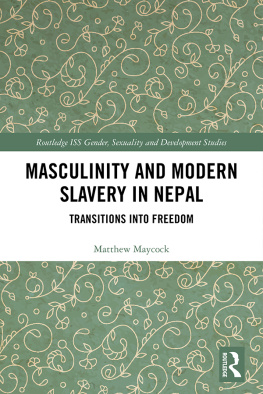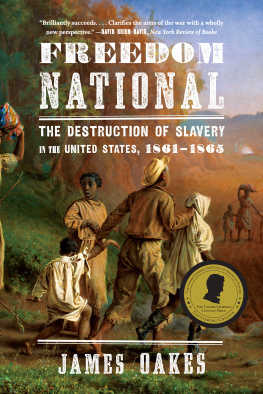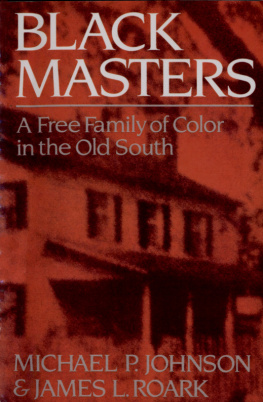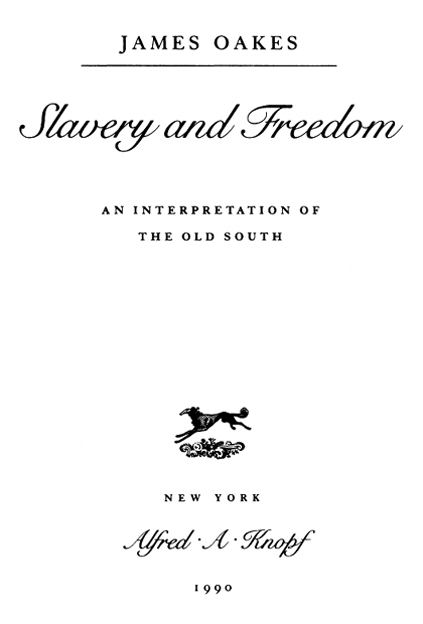THIS IS A BORZOI BOOK PUBLISHED BY ALFRED A. KNOPF, INC.
Copyright 1990 by James Oakes
Maps copyright 1990 by Alfred A. Knopf, Inc.
All rights reserved under International and Pan-American Copyright Conventions. Published in the United States by Alfred A. Knopf, Inc., New York, and simultaneously in Canada by Random House of Canada Limited, Toronto. Distributed by Random House, Inc., New York.
Library of Congress Cataloging-in-Publication Data
Oakes, James.
Slavery and freedom: an interpretation of the Old South / James Oakes.
p. cm.
eISBN: 978-0-307-82814-9
1. SlaverySouthern StatesHistory. 2. CapitalismSouthern StatesHistory. 3. Southern StatesHistory1775-1865.
I. Title.
E441.019 1990
975.00496dc20 89-43386
v3.1
ALSO BY JAMES OAKES
The Ruling Race:
A History of American Slaveholders
FOR MOM AND DAD ,
AND FOR MY BROTHERS AND SISTERS ,
JOHN
MARY
JOAN
FRANCES
JOSEPH
THOMAS
AND MICHAEL
That Liberalism may be a tendency towards something very different from itself, is a possibility in its nature.
T. S. E LIOT
The Idea of a Christian Society
Contents
Introduction
B Y TRADITION , historians are expected to introduce their books with succinct statements of what they are about. This one is about the relationship between slavery and liberal capitalism in the southern United States during the nineteenth century. As vast and unwieldy as this theme sounds, it is actually an old one in slavery studies. Slavery and capitalism have been the object of scholarly scrutiny at least since Eric Williams published his classic monograph on the subject in 1944. Slavery and liberal politics have received far less attention, but the relationship has been examined with considerable sophistication in essays and monographs by Charles Sellers, Edmund Morgan, and J. Mills Thornton, to name only a few. If I can justify any claims to novelty on this well-trodden turf, it is in the effort to integrate two otherwise distinct bodies of literaturethe one focusing on economics and the other on politicsinto a single interpretation of slavery in the Old South.
As I worked toward this synthesis I was drawn, finally, to the deceptively simple problem with which this book begins: What was slavery? The question would scarcely have seemed serious a generation ago, when most historians more or less knew slavery when they saw it, even if they disagreed vehemently about how to interpret it. But as the study of New World slavery has pushed beyond traditional boundaries of time and place, its very definition has become obscured. At the same time, however, students of slavery in the Old Worldclassical antiquity, medieval Europe, early modern Russia, and Africahave been moving in the opposite direction, toward a complex understanding of the specific character of human slavery. Within this literature M. I. Finleys studies of the ancient world have been critical.
Finley also intervened in a second field of inquirythe so-called other transition, from ancient slavery to medieval feudalism. The starting point in this discussion was Marc Blochs brilliant, posthumously published essay How and Why Ancient Slavery Came to an End. More recently, significant contributions have been offered by Perry Anderson, Chris Wickham, Pierre Bonnassie, and others. Their sustained investigation into the causes of this epochal transformation has helped distinguish slavery and slave society from serfdom, feudalism, and feudal society. This is a distinction of no mean significance. If the shift from slavery to serfdom involved profound changes that took several centuries to complete, the emergence of modern slavery must therefore have required an equally momentous turn away from feudalism. By studying the transition from Ancient Rome to Medieval Europe I was able to disentangle the totality of the master-slave relationship from the organicism of feudal social relations. Buried beneath all the confusion was a simple but critical distinction between the conditional property law that supplanted slavery in the early Middle Ages, and the absolute, or private, property that in turn supplanted medieval law with the rise of capitalism. Private property rights emerged in my mind as the Pandoras box of modern history, simultaneously unleashing the permanent revolution of capitalism and the total subordination of slavery.
For whatever reasons, the influence of these studies on the analysis of slavery in the Old South has remained unfortunately tries to bridge the gap by integrating the conceptual framework developed by students of European and African slavery with some of the themes that have been developed among historians of New Worldand especially southernslavery over the past generation.
My larger hope is that a clearer definition of slavery will in turn clarify its relationship to liberal capitalism. This is the burden of , wherein the books central thesis emerges. Stated in brief and oversimplified terms, the thesis runs like this: Because slavery is always defined as the denial of freedom, the way any given society defines freedom is inescapably tied to the way it defines slavery. Southerners took their definition of freedom from the liberal capitalist world which produced them and of which they remained a part, and this could only mean that southern slavery was defined as the denial of the assumptions of liberal capitalism. This makes the slave Souths relationship to liberal capitalism at once closer and yet far more complicated than most studies have hitherto indicated.
This interpretation can be read in very different ways. Some will see in it confirmation of the thesis that the Old South was fundamentally liberal, while others will see it as affirming slaverys intrinsic incompatibility with liberalism. This is not because of a deliberate obscurity on my part, and I certainly have no desire to create confusion. On the contrary: the ambiguous relationship of slavery and liberal capitalism has been a classic theme in western thought for more than a century. Both Marx and Weber appreciated the critical significance of wage labor, both recognized the irrational characteristics of slavery, and yet both saw that the calculated and calculating spirit of modern slavery located it firmly within the world of liberal capitalism. Only in recent years have American historians shied away from this ambiguity and portrayed the slave South as a society whose internal character was unequivocally different from, and virtually untouched by, liberal capitalism. At the risk of complicating this attractively elegant formulation, I have revived an older question: How did a social order that contradicted liberal principles as flagrantly as slavery did nevertheless accommodate itself to a liberal political culture? My short answer is that in the long run the slave South could neither escape from nor accommodate itself to liberalism, and that this was the central dilemma of slavery in the United States. A fuller answer is contained in the chapters that follow.
Did the problematical relationship between slavery and liberal capitalism make any difference to the men and women who together made the history of the South? are designed to show that it did. Slavery and liberal capitalism, not individually but in concert, shaped the way southern men and women lived their lives and encountered one another in their various social capacities as slaveholders and yeomen, husbands and wives, masters and slaves. That the relationship between slavery and liberalism invested southern society with peculiarly explosive tensions became evident in the 1860s. That slaverys abolition therefore constituted a revolutionary transformation is clear as well. In a sense, then, this book is my attempt to do what every southern historian must ultimately do: come to terms with the Civil War. If I am right, the events of 18611865 were, in the most meaningful sense of the term, a civil war. Why that was so is this books underlying question, and in my answer lies its overarching theme: that the pathway from the American Revolution to the Civil War begins at the intersection of slavery and liberal capitalism.









